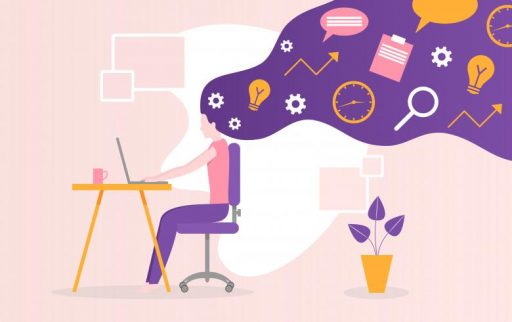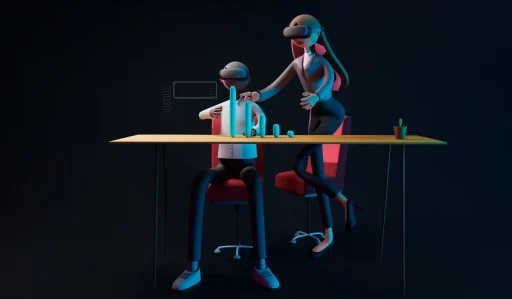In the fast-paced digital space, motion graphics have become a part of everyday life, from television commercials to our favorite movies. They are an essential tool for engaging audiences and elevating brand stories.
Doesn’t matter whether it’s creating dynamic motion graphics videos or making a smooth logo motion graphics, the role of motion graphic designer goes far beyond just simple animations.
To actually succeed in this digitally competitive industry, motion graphic designers must master several skills, from understanding the basics of motion design to developing ground-breaking 3D motion graphics and delivering the best custom motion graphics according to the client’s needs.
But let’s first understand what a motion graphic designer does exactly.
A motion graphic designer creates animated graphics for film and TV credits, advertising, digital marketing, website design, and social media channels. They primarily work with digital technology, using software like Adobe After Effects to add movement to graphics and text.
They create animated graphics for films, TV credits, advertising, digital marketing, website design, and even social media channels. They mainly work with digital technology, utilizing software like Adobe After Effects to add movement to graphics and text.
Now, the question is, how can one become a successful motion graphic designer? The simple answer is COMPTENCY!
What actually does it take to stand out as a leading motion designer is outlined in this blog. Let’s explore the 10 essential skills that every motion graphic designer must have to make motion graphics animations that not only wow audiences but also deliver a powerful message.
Importance of Learning Motion Graphic Skills!

In today’s digital age, where visual content dominates entertainment, marketing, and communication, the skill to create compelling motion graphics has become necessary. Motion graphics animation is the heart of many successful marketing strategies and projects.
Here are five key reasons to learn motion graphic skills:
- High Demand in the Industry: From advertising to film, social media, and web design, motion graphics are found everywhere, which is why mastering these skills opens doors to multiple opportunities.
- Improvs Visual Storytelling: Motion graphics allow designers to connect complex ideas through dynamic visuals, making it easier to engage and educate audiences effectively.
- Brand Differentiation: Businesses use custom and logo motion graphics to stand out from competitors and create a unique and memorable brand identity.
- Expands Creative Abilities: Acquiring animation techniques and 3D motion graphics expands a designer’s capability to make more complex and visually compelling content.
- Versatility in Content Creation: With motion graphics videos, designers can create content for multiple platforms, whether it’s for websites, social media, advertising, animations increase the reach and impact.
10 Must-Have Skills for Motion Graphic Designer
So, are you convinced now that motion graphics is leading the industry and that your business must have a motion graphic designer to create dynamic visual content for your projects?
Here are the skills you should look for in a new hire to make sure you have got the best motion graphic designer on board!
1# Strong Foundation in Graphic Designing:
A solid background in graphic designing is important to be a leading motion graphic designer, as it involves key values that enhance visual communication. Understanding the main concepts like composition, color theory, and typography is necessary for making effective animations.
- Composition involves arranging visual elements to guide the viewer’s eye and create balance while directing the attention to key messages.
- Color theory examines how colors interact and the emotions they evoke while impacting mood and branding in motion graphics.
- Typography focuses on the arrangement of type with readability and conveying tone, which is an important element for animated texts and titles.
With the understanding of these key concepts of motion design a designer can create animations that are visually appealing and effectively communicate ideas.
2# Proficiency in Animation:
Expertise in animation is important for a motion graphic designer because it allows them to create engaging 2D and 3D motion graphics that capture audience attention. Animating these graphics brings static elements to life, enhancing storytelling and visual appeal.
Key animation concepts like timing, easing, and motion paths are important in this process.
Timing refers to the speed and rhythm of movement that creates a sense of realism and emotional impact in animations.
Easing techniques adjust the acceleration and deceleration of animated elements that, adding a natural feel and making transitions smoother.
Meanwhile, proficiency in motion pats helps designers create dynamic sequences that guide viewers through the visual journey.
3# Mastery of Motion Design Software:
Excellency of motion design software is must for any motion graphic designer that aims to create high-quality motion graphic videos and custom motion graphics.
The main tools include:
Adobe After Effects: This software is the backbone of motion design that helps making complexed animations, visual effects, and compositing through features like keyframing and layering.
Cinema 4D: This is known for its user-friendly interface, Cinema 4D specializes in 3D modeling and animation, that make it ideal for creating outstanding 3D motion graphics and easily integrating with After Effects.
Blender: As an open-source of 3D creation, Blender offers a range of tools for animation, modeling, and rendering, that is perfect for exploring styles and techniques.
4# Understanding of 3D Motion Graphics:
The demand of 3D motion graphics is speedily growing across the industries, including film, gaming, advertising, and virtual reality. Popular software like Cinema 4D and Blender are commonly used to design and animate3D graphics, that allow designers to add depth and realism to the project.
Techniques such as lighting and texturing are important for making lifelike animations that improve storytelling and capture audience attention. By mastering 3D motion graphics. Designers can upgrade their skills that offers clients creative solutions that stand out in a competitive market.
5# Creativity and Storytelling:
Creativity is at the heart of designing engaging visuals in motion design. A successful motion graphic designer not only have technical skills but also the imaginative creativity to transform concepts into captivating animations that resonate with readers.
After creativity, effective visual storytelling is important for communicating a brand message. Motion graphics designers must understand the purpose behind a project and translate that into visual elements that provoke emotion and clarity.
6# Technical Skills for Rendering and Compositing:
Rendering and compositing are two skills set that significantly impact the final product pf motion design. These two skills help designers to integrate various elements to enhance the overall aesthetic of visual storytelling.
Rendering is the process of generating a final image or animation from 3D models or 2D graphics that convert all visual elements including textures, effects, and lighting into a unified output.
On the other hand, compositing involves combining multiple visual elements from different sources into a single image or sequence. This helps designers to layer animations, effects, and backgrounds.
7# Branding and Logo Motion Graphics:
Animated logos are the essence of creating brand identity that add a dynamic element to capture attention and encourage recognition. They convey a brand’s personality and values more efficiently than static images.
To design a smooth and effective logo motion graphics, a designer must consider these tips:
- Keep the animation simple and focus on straightforward animations to maintain brand clarity.
- Reflect the brand personality and align the animation style with the brand’s identity, whether it’s elegant, playful, or professional.
- Use subtle movements because gentle animations prevent distractions ad enhance the focus on the conveyed message.
- Must consider duration and aim for a short animation like 3-5 seconds to retain viewer attention.
- Always incorporate brand colors and typography and use established colors and fonts for consistency and stronger recognition.
8# Adaptability to New Trends:
As you know, the graphic design industry is constantly changing, and designers can create and deliver visuals with new animation styles and technologies. Staying adaptable to these changes is important for motion graphic designers to remain competitive and innovative.
Currently trends include:
- Kinetic Typography.
- VR Integration.
- Interactive Design.
Adapting these trends and staying informed about advancements in technology helps designers push creative boundaries and deliver top-notch visuals that resonate with modern audiences.
9# Problem Solving and Concept Development:
Before making animation, brainstorming and conceptualizing the ideas are important steps in ensuring that the final product precisely aligns with the project’s goals. This primary process helps motion graphic designers explore creative possibilities.
Successful custom motion graphics solutions often involve creative problem-solving. Designers must understand the client’s needs, overcome limitations, and find innovative ways to bring concepts to life.
10# Time Management and Organization:
Last but not least, effective time management and organizational skills are necessary for designers to deliver high-quality visuals. With complex tasks like animation and rendering, designers must optimize workflows to meet deadlines.
Tips for better output:
- Allow Buffer Time: Plan for revisions or unexpected delays.
- Plan Ahead: Break projects into smaller tasks with clear deadlines.
- Use Tools: Utilize project management tools like Trello, etc.
- Prioritize: Focus on high-priority tasks first.
- Automate: Use presents or templates for repetitive tasks.

Last Words:
Whether you’re working on branding, custom motion graphics, or 3D animations, learning these 10 essential skills helps you to create engaging visual content that aligns with a targeted audience.
If you’re looking for expert video animation services, Video Jeeves is here to help. Our team of skilled motion graphic designers is equipped with all the expertise needed to bring your projects to life. From custom animations, logo motion graphics, to dynamic motion graphics videos, we are committed to deliver top-notch animations for your brand.





